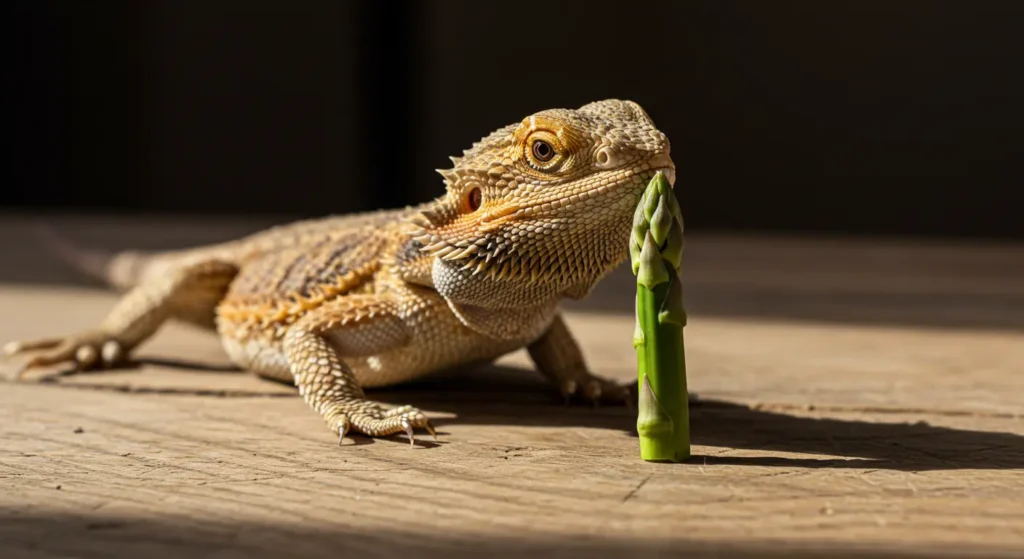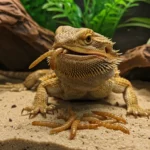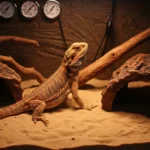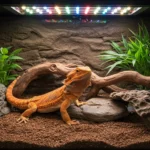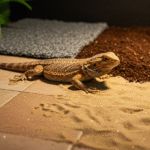As a caring reptile owner, you’ve likely asked: can bearded dragons eat asparagus? This is a smart question. Not all vegetables that are healthy for humans are safe for your beardie. You always want to make sure what goes into their food bowl supports their health, not harms it.
So, can bearded dragons eat asparagus without problems? Yes, they can—but in moderation. While asparagus isn’t toxic, it does contain oxalates. These can block calcium absorption and may contribute to serious conditions like metabolic bone disease if overfed. That’s why understanding the risks and benefits is so important.
In this complete guide, we’ll explore everything you need to know about asparagus and your bearded dragon’s diet. You’ll learn about the nutritional value of asparagus, how it affects digestion, and whether it’s best served raw or cooked. We’ll also explain the right portion size and how often it should appear in their feeding routine.
Feeding bearded dragons isn’t just about variety—it’s about balance and safety. If you’ve been wondering can bearded dragons eat asparagus, you’ll get a clear, science-backed answer here. Let’s dive into the facts and find out if asparagus deserves a spot in your reptile’s weekly diet.
can bearded dragons eat asparagus Safely?
Asparagus may look like a harmless vegetable, but can bearded dragons eat asparagus safely? Before adding it to their diet, it’s important to understand the potential benefits and risks. Let’s break down what makes asparagus safe—or not—for your reptile, including how often to feed it and whether it’s suitable for younger dragons.
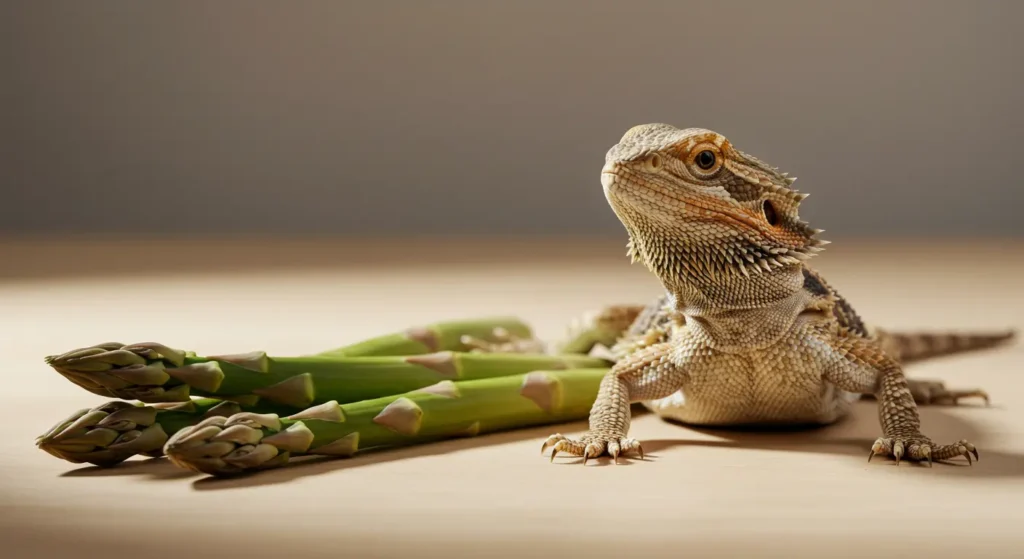
Why Can Bearded Dragons Eat Asparagus Is a Common Question
Asparagus often comes up in reptile care discussions because it’s a well-known, nutrient-rich vegetable in human diets. Many pet owners assume that if something is healthy for us, it must be good for our pets too. This logic leads to questions like “can bearded dragons eat asparagus?” and whether it fits into their feeding plan.
The vegetable is easy to find, affordable, and loaded with fiber and hydration—two things that sound ideal for any reptile. However, reptiles like bearded dragons have very different digestive systems compared to mammals. What seems like a nutritious treat may not be fully beneficial—or safe—for them. Asparagus also contains compounds like oxalates, which raise concerns about calcium binding and bone health. Because of its benefits and possible risks, asparagus has become one of the most frequently asked-about vegetables in reptile forums and veterinary offices alike.
Is Asparagus Toxic or Non-Toxic to Bearded Dragons?
Asparagus is non-toxic to bearded dragons, which means they can eat it without immediate harm. However, non-toxic doesn’t automatically mean ideal. While asparagus won’t poison your dragon, it contains substances like oxalic acid that can pose long-term health concerns if overfed.
Oxalates in asparagus can bind with calcium, reducing its availability in your dragon’s system. Since bearded dragons require high levels of calcium to maintain healthy bones and prevent Metabolic Bone Disease (MBD), this makes asparagus a risky choice in large amounts. It’s best treated as an occasional addition to their vegetable rotation rather than a staple food.
So, can bearded dragons eat asparagus? Yes, but only in small, infrequent servings—and only if the rest of their diet supports proper calcium intake.
Can Baby or Juvenile Bearded Dragons Eat Asparagus Too?
Technically yes—but it’s not recommended. Baby and juvenile bearded dragons have much higher needs for calcium and protein, which are essential for healthy bone growth and development.
Asparagus contains oxalates and has a poor calcium-to-phosphorus ratio, making it a risky choice for young dragons. Even occasional servings can interfere with calcium absorption, increasing the chance of Metabolic Bone Disease (MBD).
👉 If you still want to try asparagus, wait until your bearded dragon is at least 10 to 12 months old. At that stage, offer only a tiny, chopped portion, and always pair it with calcium-rich greens like collard or mustard greens—along with proper UVB lighting.
🦎 Bottom line: Asparagus is not ideal for baby bearded dragons. Stick to insects and high-calcium vegetables for the first year.
How Often Can Bearded Dragons Eat Asparagus Without Risk?
Bearded dragons can safely eat asparagus, but only in moderation. Experts recommend offering it no more than once every two to three weeks. This limited frequency helps reduce the buildup of oxalates in your dragon’s system and prevents long-term calcium absorption issues.
You should treat asparagus as an occasional snack—not a staple. Their core diet should consist of safer leafy greens like collard greens, dandelion greens, or mustard greens, which have better calcium ratios and lower oxalate content. Overfeeding asparagus could lead to imbalances that increase the risk of Metabolic Bone Disease (MBD), especially if their lighting or calcium supplementation is not ideal.
When feeding asparagus, chop it finely, serve it raw or lightly steamed, and mix it with a variety of other vegetables. This variety mimics their natural diet and reduces the chance of nutrient deficiencies.
Understanding the Nutritional Value of Asparagus
Before adding asparagus to your bearded dragon’s diet, it’s important to understand what this vegetable actually offers in terms of nutrition. In this section, we’ll break down its vitamin and mineral content, calcium-to-phosphorus ratio, and other key factors that impact your beardie’s health.
Can Bearded Dragons Eat Asparagus for Its Vitamins and Minerals?
Asparagus is packed with essential vitamins and minerals, which is why some owners consider offering it to their bearded dragons. It contains vitamins A, C, E, and K, along with small amounts of B vitamins like folate. These nutrients support the immune system, skin health, and blood clotting. It also offers trace minerals such as potassium, iron, and magnesium.
However, while these nutrients are beneficial, the levels in asparagus may not be high enough to meet your bearded dragon’s full dietary needs. For example, it lacks the calcium content found in more appropriate leafy greens like collards or mustard greens. Vitamin A is present in its active form, which can build up if overfed—posing a risk of toxicity.
In short, asparagus can add some nutritional variety, but it should never replace more balanced staple vegetables. Its role should be minor in your dragon’s overall feeding plan.
Calcium to Phosphorus Ratio: Why It Matters
The calcium to phosphorus ratio is a critical aspect of any reptile’s diet. For bearded dragons, the ideal ratio is 2:1 in favor of calcium. This balance helps ensure strong bones, proper muscle function, and healthy metabolic processes.
Unfortunately, asparagus has a poor calcium-to-phosphorus ratio. It contains significantly more phosphorus than calcium—about 1:2 in reverse of what’s ideal. Phosphorus binds with calcium inside the body, making it harder for your bearded dragon to absorb the calcium they need. Over time, this can lead to deficiencies and serious issues like Metabolic Bone Disease (MBD).
Because of this imbalance, asparagus should only be offered occasionally and never as a dietary staple. It’s crucial to pair it with high-calcium foods and maintain proper UVB exposure to support calcium metabolism.
Should Bearded Dragons Eat Asparagus with Oxalates?
One of the biggest concerns with feeding asparagus to bearded dragons is its oxalate content. Oxalates (or oxalic acid) are natural compounds found in many vegetables. In reptiles, oxalates can bind to calcium during digestion and block its absorption.
When bearded dragons consume too many oxalate-rich foods like asparagus, they may not get enough usable calcium—even if their diet seems balanced on the surface. Over time, this hidden deficiency can contribute to Metabolic Bone Disease (MBD), a painful and potentially fatal condition that weakens the skeleton and impairs mobility.
While asparagus doesn’t have the highest oxalate content compared to spinach or beet greens, it’s still enough to raise concerns when offered too frequently. For that reason, always treat asparagus as an occasional food and prioritize low-oxalate, high-calcium vegetables in your beardie’s weekly diet.
Can Bearded Dragons Eat Asparagus for Digestive Support?
Asparagus provides a decent amount of dietary fiber and water, both of which can benefit your bearded dragon’s digestive health when fed appropriately. Fiber helps regulate bowel movements, reducing the risk of constipation. Its natural water content can also support hydration—especially important for reptiles that don’t always drink from standing water.
However, too much fiber from the wrong sources can lead to loose stool or even gastrointestinal upset. This is why balance is key. Asparagus can serve as a mild digestive aid, but it shouldn’t be relied upon as the main fiber source in your dragon’s diet.
Hydrating vegetables like squash, cactus pads, and occasional cucumber slices are generally better options. When used sparingly, asparagus can support hydration and digestion—but only as a small part of a diverse, reptile-appropriate meal plan.
Feeding Asparagus to Bearded Dragons the Right Way
Knowing that asparagus is safe in moderation is only the first step—how you prepare and serve it matters just as much. In this section, we’ll walk you through the best ways to offer asparagus to your bearded dragon, from preparation methods to portion sizes and feeding frequency.
Raw vs. Cooked Asparagus: Which Is Better for Beardies?
When deciding how to feed asparagus to your bearded dragon, the first question is whether it should be raw or cooked. Both options are technically safe, but they serve different purposes. Raw asparagus maintains more of its original nutrients, such as vitamins and fiber. However, it’s also firmer, which may make it tougher for some dragons to chew and digest.
Cooked asparagus—especially when lightly steamed—becomes softer and easier to chew. Cooking also reduces the oxalate content slightly, which can make it safer for calcium absorption. On the downside, excessive cooking can destroy heat-sensitive nutrients like vitamin C.
If you choose to cook asparagus, avoid adding oil, salt, or seasoning of any kind. Steaming or boiling in plain water is best. For most beardies, a small serving of finely chopped raw or lightly steamed asparagus once in a while can provide variety without causing harm. Always monitor your pet after trying a new food.
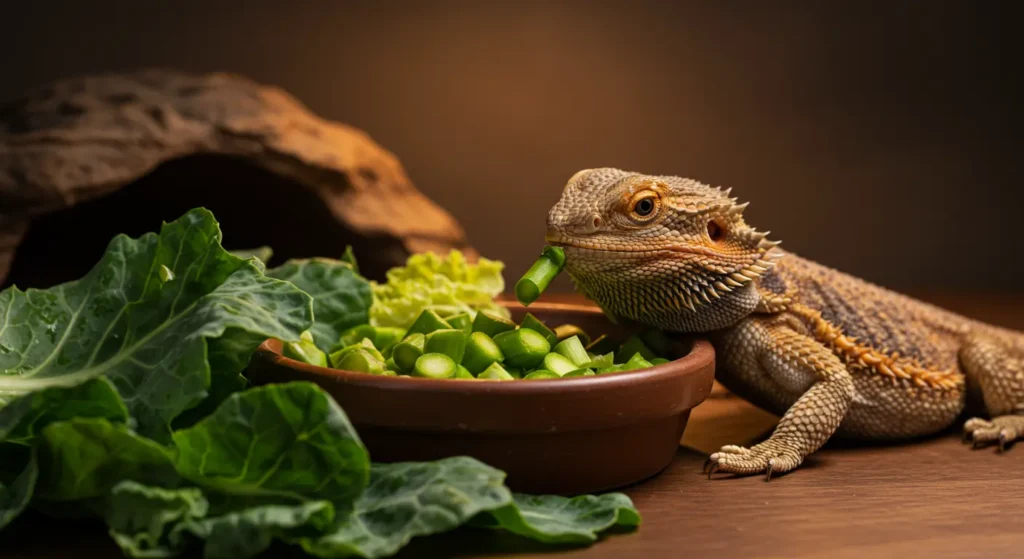
How to Prepare and Serve Asparagus Safely
Proper preparation ensures that asparagus doesn’t pose a choking hazard or cause digestive problems. Always start by choosing fresh, pesticide-free asparagus. Wash the spears thoroughly to remove dirt and any chemical residue. Remove the tough, fibrous ends and chop the asparagus into very small, bite-sized pieces.
Some owners prefer to peel thick spears before chopping, which can help reduce stringiness and improve digestibility. If cooking the vegetable, steam it lightly—never use oil, butter, or seasoning. Let it cool before serving.
Mix the asparagus with other safer vegetables to help balance the calcium-to-phosphorus ratio. Good pairings include collard greens, mustard greens, or dandelion greens. Serve it in a shallow dish, and remove any uneaten food within a few hours to prevent spoilage.
Following these steps makes it easier for your bearded dragon to chew, digest, and absorb nutrients safely from this occasional treat.
can bearded dragons eat asparagus in These Portion Sizes?
Even though asparagus is non-toxic, it should only make up a very small portion of your bearded dragon’s diet. A good rule of thumb is to offer no more than 5–10% of the total vegetable intake, and only once every two to three weeks.
A few small, chopped pieces—roughly the size of your dragon’s eye—are enough for one serving. Overfeeding asparagus can lead to calcium imbalance due to its oxalate content and poor calcium-to-phosphorus ratio.
You should also consider the age and health of your dragon. Juveniles and babies need higher calcium and protein intake, so asparagus is not ideal for them. Adults can tolerate it better, but still require a diet based on dark, leafy greens and insects for proper nutrition.
Use asparagus as an occasional side dish, not a staple. Sticking to these portion and timing guidelines helps prevent digestive issues and long-term health risks.
Signs Your Bearded Dragon Didn’t React Well
It’s important to watch for any negative reactions after feeding your bearded dragon asparagus. While rare, some dragons may have difficulty digesting it—especially if they’re not used to fibrous vegetables.
Common warning signs include diarrhea, lethargy, bloating, or a lack of appetite in the hours or days following the meal. In some cases, a bearded dragon may simply ignore the food, which could mean it dislikes the texture or smell.
If your pet shows any unusual behavior after eating asparagus, remove it from the diet immediately and monitor them closely. Make sure their enclosure temperature and UVB lighting are also correct, as poor habitat conditions can exaggerate dietary issues.
For severe or persistent symptoms, consult a reptile veterinarian. Even safe foods can cause problems when fed improperly or too often. Observing your beardie after trying new foods like asparagus ensures their diet remains safe and balanced.
Potential Risks of Including Asparagus in Their Diet
While asparagus may seem harmless, it comes with nutritional drawbacks that every bearded dragon owner should understand. In this section, we’ll explore the key risks associated with feeding asparagus, including how it may impact calcium absorption, digestion, and overall health if not offered correctly.
Can Asparagus Lead to Calcium Deficiency or MBD?
Asparagus may be non-toxic, but feeding it too often can contribute to calcium deficiency in bearded dragons. This risk stems from its unfavorable calcium-to-phosphorus ratio, where phosphorus outweighs calcium. When phosphorus levels are too high, they bind with calcium in the digestive tract, making it unavailable for absorption.
Over time, this imbalance can lead to Metabolic Bone Disease (MBD), a serious condition that weakens bones, causes deformities, and affects mobility. MBD is preventable, but only with careful attention to diet, lighting, and calcium supplementation.
Asparagus doesn’t directly cause MBD, but it can increase the risk if it replaces more calcium-rich vegetables or is offered too frequently. To prevent this, only serve asparagus occasionally and always combine it with high-calcium foods. Providing proper UVB exposure also plays a critical role in calcium metabolism. The key is moderation and balance.
Understanding Oxalic Acid and Its Dangers
Asparagus contains oxalic acid, a naturally occurring compound that can interfere with calcium absorption in reptiles. When oxalic acid binds to calcium, it forms insoluble crystals that the body cannot use. This not only limits calcium availability but can also strain the kidneys over time.
Bearded dragons are particularly vulnerable to calcium imbalance. Oxalates from asparagus, when consumed in large quantities or too frequently, may contribute to hypocalcemia, which can progress into Metabolic Bone Disease if left unmanaged. Even if you supplement calcium, oxalates can reduce its effectiveness.
Compared to vegetables like spinach or beet greens, asparagus has a moderate level of oxalates, but it’s still high enough to warrant caution. Limiting the portion size and mixing asparagus with low-oxalate, high-calcium foods can reduce this risk. A strong diet and good UVB exposure help minimize the dangers of oxalic acid.
Gastrointestinal Issues and Overfeeding Warnings
Overfeeding asparagus can upset your bearded dragon’s digestive system. While fiber is essential for regular bowel movements, too much fiber from asparagus may lead to loose stools or diarrhea. This is especially true if your dragon isn’t used to fibrous vegetables.
Some bearded dragons may also experience bloating, temporary appetite loss, or even mild lethargy after eating too much asparagus. These signs often appear within 24 hours of consumption. The risk increases if the vegetable is served in large amounts or paired with other high-water foods like cucumber or lettuce.
To avoid digestive problems, offer only small, finely chopped servings of asparagus. Always introduce new foods gradually and monitor how your dragon reacts. If their stool changes consistently after eating asparagus, reduce the portion size or remove it altogether. A slow and cautious approach prevents unnecessary stress on their digestive system.
When to Consult a Reptile Veterinarian
Most bearded dragons tolerate small amounts of asparagus without issue, but it’s still important to know when to seek veterinary help. If your dragon shows unusual behavior after eating—such as frequent diarrhea, loss of appetite, weakness, or swelling—it may indicate a dietary imbalance or underlying health problem.
Persistent signs of calcium deficiency, like twitching limbs, soft jaw, or difficulty moving, should never be ignored. These symptoms may point to Metabolic Bone Disease, which requires professional diagnosis and treatment. Even subtle changes in energy, color, or appetite can signal something deeper.
It’s always better to consult a qualified reptile veterinarian early rather than wait for symptoms to worsen. Be sure to share your pet’s full diet, lighting setup, and feeding habits during the visit. Proper care and early intervention can correct minor issues before they become life-threatening.
What to Feed Instead of Asparagus for Better Nutrition
While asparagus can be offered occasionally, it shouldn’t play a major role in your bearded dragon’s diet. In this section, we’ll look at healthier, calcium-rich vegetables and safe treats that provide better long-term nutritional value for your beardie.
Best Staple Vegetables for Bearded Dragons
Staple vegetables are the foundation of a healthy bearded dragon diet. These veggies should be offered daily and provide key nutrients—especially calcium—without the risks that come with foods high in oxalates or phosphorus. Some of the best choices include collard greens, mustard greens, turnip greens, dandelion greens, and endive.
These leafy greens are low in oxalates and rich in calcium, making them ideal for supporting bone health and preventing Metabolic Bone Disease (MBD). They’re also easy to chop and mix with other foods, which keeps your dragon’s meals varied and interesting.
Aim to fill at least 70–80% of your adult bearded dragon’s veggie intake with these staples. Rotate them often to avoid boredom and ensure nutritional variety. Avoid iceberg lettuce or spinach, as these either offer poor nutritional value or contain high levels of oxalates. By focusing on these staple greens, you create a safe and nutrient-dense base for your dragon’s plant-based meals.
Occasional Treats That Are Safer Than Asparagus
Treats can add variety and enrichment to your bearded dragon’s diet—but they should be offered wisely. Safer alternatives to asparagus include squash, bell peppers, zucchini, and cactus pads (nopales). These vegetables are lower in oxalates and offer hydration, fiber, and vitamins without the calcium-binding concerns that asparagus brings.
Fruits like blueberries, raspberries, and mango can also be offered sparingly—no more than once a week. These contain sugar, which beardies don’t need in large amounts. However, they’re excellent for encouraging picky eaters or hiding supplements like calcium powder.
Treats should never make up more than 10–15% of the overall diet. When you do offer them, mix them in small amounts with staple greens. This not only reduces health risks but also helps your dragon associate nutritious foods with pleasant flavors and textures.
Creating a Balanced Weekly Veggie Rotation
A well-planned weekly veggie rotation is one of the best ways to ensure your bearded dragon gets a complete range of nutrients. Start with a strong foundation of calcium-rich staple greens—like collards, dandelion greens, and mustard greens—and rotate them every few days to prevent nutritional gaps.
Add occasional low-oxalate veggies such as butternut squash, green beans, and carrots for variety. Include small amounts of colorful vegetables, like bell peppers or zucchini, to keep meals visually stimulating and appetizing.
Avoid feeding the same veggies every day. Instead, prepare a basic weekly schedule with 3–4 rotating core greens and 1–2 rotating treat vegetables. This helps avoid overexposure to any one compound, like oxalates or goitrogens, and keeps your dragon’s digestive system functioning smoothly.
With this method, your bearded dragon receives the right mix of nutrients across the week without dietary monotony or risk of imbalance.
Trusted Resources and Vet Recommendations
When it comes to your bearded dragon’s health, accurate, science-based information is crucial. Rely on trusted sources like The Veterinary Manual (MSD), the Association of Reptilian and Amphibian Veterinarians (ARAV), and well-reviewed reptile care books and websites.
Forums and social media can provide anecdotal help, but always double-check advice with a qualified reptile veterinarian. Every bearded dragon is different, and factors like age, activity level, lighting, and health status affect dietary needs.
Scheduling annual wellness checkups with a reptile-savvy vet is also essential. These checkups can catch early signs of nutritional imbalances or deficiencies. Bring a record of what you feed, how often, and what supplements you use. Your vet can recommend changes that support long-term health and adjust the diet based on your pet’s current condition.
Staying informed through credible resources ensures that your bearded dragon thrives with confidence and care.
Conclusion
So, can bearded dragons eat asparagus? Yes—they can, but only in small, occasional amounts. While asparagus isn’t toxic, it comes with certain drawbacks, including a poor calcium-to-phosphorus ratio and moderate oxalate content. These factors make it unsuitable as a regular part of your dragon’s diet.
If you decide to offer asparagus, make sure it’s finely chopped, served raw or lightly steamed, and always paired with calcium-rich, low-oxalate vegetables. Keep portion sizes small and feed it no more than once every few weeks. Monitoring your beardie for any unusual reactions after feeding is also important.
Ultimately, the healthiest bearded dragon diet is one built on variety, balance, and nutrient-rich staples. By understanding the risks and benefits, you can make informed decisions and offer your reptile the best possible care. Now that you know the facts, you can confidently answer the question: can bearded dragons eat asparagus? Yes—but only with care and moderation.

